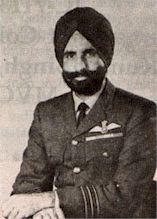Prem Pal Singh
Wing. Commander Prem Pal Singh was commissioned in the Indian Air Force on 15 April 1950. In the beginning he served as a Dakota pilot but later he switched over to the Canberra aircraft. During the Indo-Pak War 1965, Wing Commander Prem Pal Singh commanded No. 5 "Tuskers" Squadron, stationed at Agra. The unit equipped with the Canberra bomber, was assigned the triple task of tactical bombing, close support and armed patrolling. Under his able guidance the squadron carried out tactical bombing of various targets to destroy the Pakistan Air Force on the ground. Led by Wing Commander Prem Pal Singh himself, Pak army camp east of Gujarat and airfields at Chaklala, Dab, Murid, Akwal, Risalwala, Wagowal, Sargodha and Peshawar were successfully attacked by his bombers.
The squadron gave close support to the army in Kasur, Khem Karan, Pasrur, Chawinda and Sialkot sectors. Bombs were dropped on the enemy concentrations at all these places. During the period of war the squadron undertook 39 sorties of armed patrolling over Agra, Palam, Ambala, Halwara and Adampur. Most of the operational missions over the enemy territory were carried out during the hours of darkness. The targets were identified in the moon-light. These dangerous operational sorties were undertaken in the face of heavy enemy anti-aircraft fire with exceptional courage and determination.
Wing Commander Prem Pal was awarded the Mahavir Chakra for displaying a high sense of duty and gallantry. Wg Cdr Prem Pal Singh, subsequently rose to the rank of Air Marshal. He was awarded AVSM and PVSM for distinguished service.
With a second Sikh in command the No. 5 "Tuskers" win fame in another war
No. 5 "Tuskers" Squadron would later under another Wing Commander, Mohanbir Singh Talwar, also a Sikh, garner acclaim for its bombing missions during the Bangladesh War of 1971.
Both Mohanbir Singh Talwar and Prem Pal Singh have added to the List of Sikhs who have served their country in its times of need. The weapon they used, the Canberra, has had a long and illustrious career.
A Word on the Canberra
Designed during WWII the aircraft did made its first flight in 1949. As Australia was the first to order the bomber it was named after their capital, Canberra. Designed by British Electric the planes, which served in the air forces of many nations, soon earned the nickname 'the old workhorse'. On 1st September 1957 the "TUSKERS" became the first IAF Squadron to re-equip with the Canberra jet bomber aircraft. The TUSKERS pioneered the development and operational expansion of the Canberra fleet in the IAF. Many different versions of the Canberra served in the IAF for almost a half century. On 19 December 2005 the entire IAF Canberra fleet was grounded and then retired following the crash of an IAF Canberra in Agra, India.
5th Tusker's Emblem
The 5th Tusker's Emblem, a Wild Asian elephant sounding its 'trumpet' before charging, symbolises the enormous strength the unit intended to rain upon any of India's enemies. The buddha hathi (wise , old tusker) is rampant upon a rondele topped by India's state emblem (the Sarnath Lion Capital of Emperor Ashoka). The squadron's motto is inscribed in Sanskrit, Shakti Vijayeete (Strength is Victorious).

